Adobe Audition is an audio editing application that I am increasingly impressed with; especially with the death of Soundtrack Pro.
My career in media began so long ago that, well, let’s just say that faders were large rotating knobs and not sliders, and we could still buy records that spun at 78 rpm. (And for the younger set, here’s a description of a 78 record…)
Anyway, lest I wax too nostalgic, my audio career evolved from analog into ProTools, from ProTools to Soundtrack Pro, and from Soundtrack Pro to… ?
As Apple was phasing out Soundtrack Pro, Adobe announced the CS5.5 release of Adobe Audition which brought this audio recording and editing software to the Mac. I’ve been looking at it ever since. As every editor knows, making the transition from one major editing application to another is fraught with all kinds of stress and as more of my work involves audio than video, my stress level was higher than usual.
However, Adobe Audition, while new to the Mac, is very well-established in the broadcast industry and professional audio on Windows. A couple of months ago, I finally decided to take a closer look.
Out of that has evolved a series of video training on how to record and edit audio using Audition. (Click here for a list.) I’m releasing another session on mixing and effects shortly.
For this article, though, I want to share some quick tips on working with Audition There are some very cool features here that you might not find right away.
NOTE: By the way, we’ve made the decision to use Audition for our NAB Show audio coverage in April in Los Vegas. Stop by our booth if you want to see it in action – South Lower 11505. I’ll also write up our experience as a blog post shortly after NAB ends.
WORKSPACES
There are close to 20 different panels and tabs in Audition. If all of these were displayed at once, space would be so cramped that we wouldn’t be able to get any work done.
Instead, Adobe created Workspaces – organizations of related tabs and panels that revolve around common tasks.
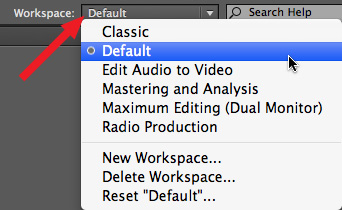
When I’m doing audio-only work, I like the Default workspace. When I’m mixing to picture, I like Edit Audio to Video. You can create, modify, reset, and delete your own workspaces, allowing you to customize the interface as much as you want.
For the screen shots in this article, I’ll use the Default workspace.
KEYBOARD SHORTCUTS
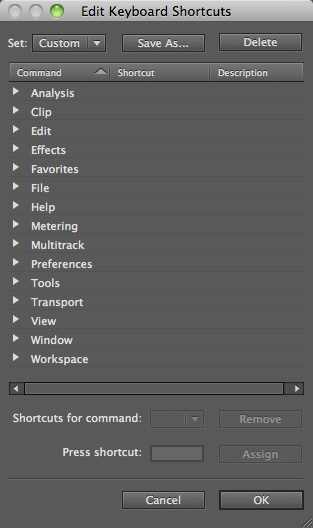
A feature I really like is the ability to create your own keyboard shortcuts. However, this option is located under the Edit menu, not Audition, so you may overlook it. This would be a mistake.
Not only can you assign keyboard shortcuts to menu items, you can also assign them to workspaces, audio meter ranges, help files, preferences, transport controls….
If you are a power user with the need for speed, this, alone, will make your heart beat faster.
OPEN VS. IMPORT
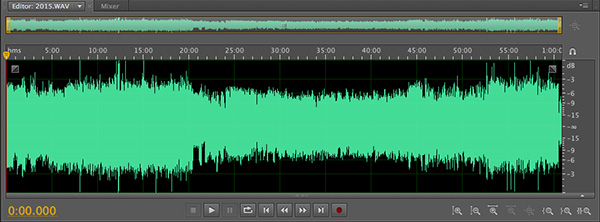
Audition allows you to open Audition sessions, Adobe Premiere Pro XML sequences for mixing, Final Cut Pro XML sequences for mixing, and and huge variety of audio file formats, including WAV and a variety of PC formats that Soundtrack didn’t support.
NOTE: Did you notice I said that Audition opens FCP 7 XML files so you can mix your FCP projects in Audition? You aren’t limited to using OMF. Very cool.
When you select File > Open, sessions open into the Multitrack timeline and audio files open into the Waveform editor.
When you select File > Import, sessions open into the File Browser and audio files are imported and loaded into the Waveform editor, but placed behind the currently displayed multitrack project or waveform.
In other words, if you want to open a file and see it immediately, select File > Open. If you want to open it, but look at it later, select File > Import.
MAKE A QUICK FIX
Notice the varying audio levels in the screen shot above? What if you want to open a file, get rid of garbage at the top and tail, even out the levels, save it, and get on with your life fast – for example, to quickly extract a sound bite from an interview. Here, Audition’s speed is amazing:
1. File > Open
2. Select the portion of the waveform you want to remove
3. Press Delete – repeat Steps 2 & 3 until your clean up is done
3. Apply Effects > Amplitude & Compression > Speech Volume Leveler
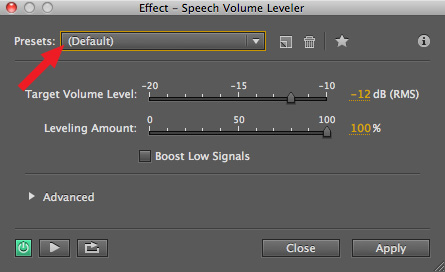
4. Accept the defaults and press OK.

5. Poof! Levels are smooth and your audio sounds great.
6. Save the file.
Done. (I wish I learned this trick a LONG time ago…!)
NAVIGATION

These eight buttons allow you to zoom vertically, horizontally, to the In, to the Out, or, my favorite, zoom the selection to fill the window!
Need a faster way? Every one of these has a keyboard shortcut. Shift+S zooms into the selection.
Need something still faster?
+ Zooms in
– Zooms out
Need the flat out FASTEST way? Roll the mouse scroll wheel to zooms in or out!
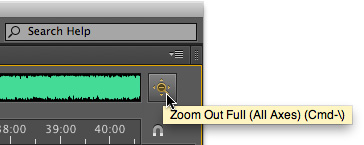
Click the Zoom Out Full button to fit your entire clip into the Window and reset track heights.
A faster way, though, is to type Command +
CREATING A MIX
The Waveform Editor is used to edit audio. Generally, this makes destructive edits, and you save the results to your hard disk. For mixes, though, you use a Multitrack session. This is exactly the same process used by Soundtrack Pro.
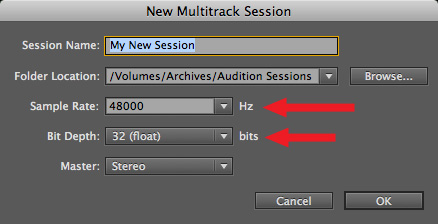
A HUGE caution with Audition, however, is that you need to specify the audio specs of the session before you start adding clips to it.
AND, even more important, your audio sample rates need to match the session settings. If they don’t, Audition won’t allow you to add the audio clips to the timeline.
For all the audio recording I do for my podcast, Digital Production Buzz, I standardized on a sample rate of 44,100 Hz. For the audio recording I do for video, I’ve standardized on a sample rate of 48,000 Hz. Soundtrack allows you to mix and match sample rates – so does Final Cut Pro, for that matter. However, Audition does not.
But, it is very fast and easy to convert sample rates using setting presets in Compressor, in case I have a problem with an audio file not having the correct sample rates. For that matter, Audition also supports batch audio file processing.
All my audio recordings use 16-bit depth. This is fine for recording. Audition defaults to 32-bit float space for mixing. This is ideal for mixing and should be left alone. It is perfectly OK, and, in fact, recommended, that you mix 16-bit audio in 32-bit float space. This provides more room for effects to work and helps your audio sound better.
NOTE: Once you set the sample rate for a multitrack session, it can not be changed.
ADDING AUDIO
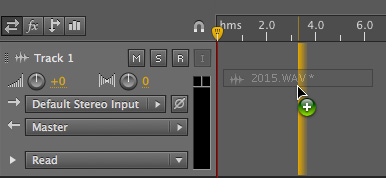
To add audio from the File Browser to the Multitrack timeline simply drag it. The gold border indicates the start of the clip.
Want to open a clip into the Waveform editor? Double-click it.
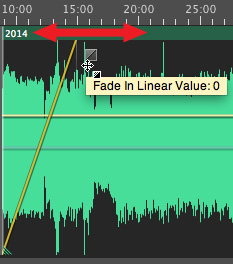
Looking for a fast way to create a fade? Grab the fade box in the corners and drag left or right.
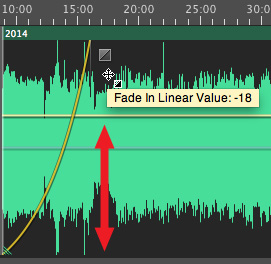
Want to change the shape of the fade? Drag the fade box up or down.
EDITING AUDIO
To select the Arrow tool, press V — same as Photoshop
To cut a clip, press R (or RR) for the razor blade to cut a single (or all) tracks.
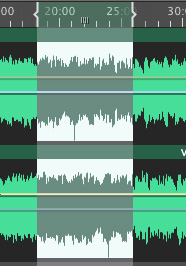
To select a range within a clip, press T — the Time Selection Tool and drag to select a region.
To select a region across tracks, drag across the tracks.

To move the region, drag the selection area at the top.
To change the In or Out of the region, drag the In or the Out at the top.
To delete a region and leave a gap, press Delete.
To delete a region and remove the gap, press Shift + Delete.
OTHER GOODIES
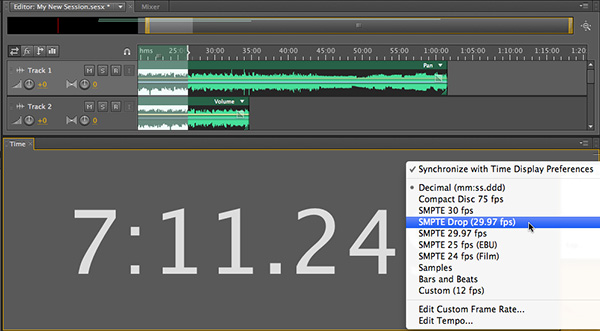
Want some seriously big Timecode? Go to Window > Time and drag the top divider up, and UP! To select the type of time display, right-click in the Time window and pick your poison.

Need to see both the highs and the lows? Control-click in the audio meters and turn on both Peaks and Valleys. Peaks (yellow line) show the loudest peaks in your audio for the last three seconds. Valleys (gray line) show the softest parts of your audio for the last three seconds. I don’t know why, but I love this feature.
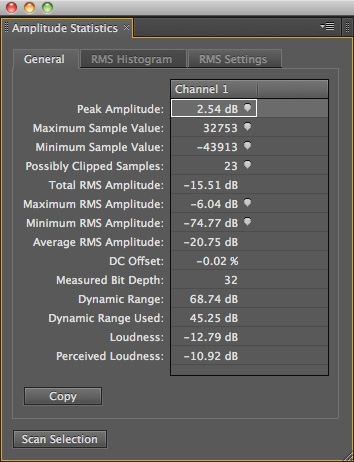
Want to know PRECISELY how loud your audio is? Open your clip in the Waveform Editor, then choose Window > Amplitude Statistics. Click Scan, in the low-left corner. Instant stats.
There are more details in this one window than I have time to explain — EXCEPT, notice that this not only displays peak levels, but RMS (average) levels and actual loudness. If you, like me, keep getting into arguments about whether audio levels should be expressed as peak or RMS, this one screen will ease a lot of tension.
FINAL THOUGHT
There is a lot for Final Cut editors to like with Audition. I’m really looking forward to showing you more about Audition in the future.
NOTE: Have your own favorite Audition trick? Add it to the comments below.
51 Responses to Adobe Audition: Quick Power Tips
Newer Comments →-
 Florante says:
Florante says:
December 15, 2012 at 11:02 pm
-
 Larry Jordan says:
Larry Jordan says:
December 16, 2012 at 9:35 am
-
 Craig Fry says:
Craig Fry says:
May 16, 2013 at 10:42 am
-
 Larry Jordan says:
Larry Jordan says:
May 16, 2013 at 11:13 am
-
 Kendrick says:
Kendrick says:
August 7, 2013 at 10:53 pm
-
 Larry Jordan says:
Larry Jordan says:
December 15, 2013 at 11:26 pm
-
 Craig Fry says:
Craig Fry says:
October 15, 2013 at 2:28 pm
-
 Larry Jordan says:
Larry Jordan says:
October 15, 2013 at 7:46 pm
-
 Paul says:
Paul says:
November 13, 2013 at 3:00 pm
-
 Achu says:
Achu says:
December 15, 2013 at 11:14 pm
-
 Larry Jordan says:
Larry Jordan says:
December 15, 2013 at 11:24 pm
-
 Achu says:
Achu says:
December 17, 2013 at 2:21 am
-
 Larry Jordan says:
Larry Jordan says:
December 17, 2013 at 9:29 am
-
 D Kennedy says:
D Kennedy says:
March 24, 2014 at 9:04 am
-
 Ryan says:
Ryan says:
March 10, 2014 at 1:47 pm
-
 Larry Jordan says:
Larry Jordan says:
March 10, 2014 at 2:15 pm
-
 Angel says:
Angel says:
March 23, 2014 at 10:40 am
-
 Larry Jordan says:
Larry Jordan says:
March 23, 2014 at 11:08 am
-
 Angel says:
Angel says:
March 23, 2014 at 11:43 am
-
 Piers says:
Piers says:
April 22, 2014 at 4:40 am
-
 Larry Jordan says:
Larry Jordan says:
April 22, 2014 at 8:21 am
-
 Piers says:
Piers says:
May 2, 2014 at 4:30 pm
-
 Lisa Genuit says:
Lisa Genuit says:
May 20, 2014 at 1:57 pm
-
 Larry Jordan says:
Larry Jordan says:
May 20, 2014 at 2:08 pm
Newer Comments →Hi Larry,
I’m just starting with Adobe Audition and I think this is a real fine tool. I previously had Adobe Soundbooth so it’s not very alien to me. I’ve tried Audacity as well as WavePad but so far, Audition stands out. I will be following your tips and I’ll look forward to learning more about Audution with your great tips.
Cheers
Florante
Thanks for the kind words!
If you want to learn Audition quickly and in-depth, check out this training that I did for the CS6 release:
http://www.larryjordan.biz/app_bin/Store/catalog/product_info.php?products_id=283
Larry
Hi Larry,
I may have missed it, but I didn’t see the critical words “for Mac” anywhere in the description of the complete training course you mention above, and the image on the linked page appears to be a Windows interface. Please let me know if this complete training is available for the Mac version of Audition. I’ve been working with the demo and it appears to be extremely powerful and versatile, but having relied almost exclusively on Peak for 10 years, there is a substantial learning curve. Thanks,
-Craig
Craig:
All our training is recorded on Macs for Macs. However, the Audition interface is identical for both Windows and Macs, so our training works for both.
Larry
Hello…i love this program but i hate that everytime i record audio its automatically saves…i want to only save files which are used within a session! how do i make this possible. i need help thankyou
Kendrick:
All audio is immediately saved to disk the instant it is recorded. The guards against catastrophic loss in the event of a power failure.
You can always delete the tracks you don’t need from your hard disk afterword. They are stored in the Media folder that is alongside the Audition project file.
Larry
I am not finding any way to export AIFF files with loop markers that can be read by soundfont authoring software. A significant part of my work is creating looping wavetable instrument samples for MIDI toy chips, so being able to save out samples with loop markers is important. Is there a way to do this with Audition?
Thanks,
-Craig
Craig:
I just checked.
Audition doesn’t currently write custom markers such as this. However, depending on the authoring software, it may be able to recognize
the standard Cue Marker regions and assign them as the looping portion of a sample.
See if that work-around works.
Larry
Hi Larry, i noticed while using cs6 that i don’t get the scroll effect that 3.0 gives me. please is there a setting that can give me this effect?.
Expecting your soonest reply.
Thanks
Hello,
I tried recording with multiple tracks(Guitar and Vocal) mixed together. But when I exported to .wav format, I’am getting the guitar track only in left and vocal track only in right speakers. Whys is it so? did I miss any setting here? Please help
Achu:
Sounds like you need to change the pan settings on each track. From your description, the guitar is panned to one side and the vocals to the other.
Pan controls are in the track header on the left of each track.
Larry
Thanks Larry,
Found my mistake. Might need your advice again.
While recording the individual tracks, My Vocal track is getting recorded only on the left and the guitar track is recorded only on the right. So when I add these tracks in to a multi track session, even if the pan is on the middle, the tracks gets saved on separate sides. I do not have any idea on how to control the stereo (to get the wavefronts on both sides on a single track).
Achu:
Select each track in the Files panel. Right-click and select “Extract to Mono Files.”
This creates separate tracks of your stereo clip. Put the appropriate mono track back into the timeline and adjust pan and levels to suit.
Larry
I would also check your input settings. this is often the case when someone uses a mono input but has the setting noted for stereo.
Hi Larry,
In FCP 7 you could select “mark audio peaks” and it would put a marker in every instance of the audio peaking. Is there a way to do that with Adobe Audition?
Ryan:
Not to the best of my knowledge.
Larry
Hello Larry,
When I record voiceover audio and bring in a music track for a multitrack project in Adobe Audition CC, the entire project sounds like its playing thru my headphones when I play it back thru my mac book pro or iMac.
What am I doing wrong?
Please help Larry,
Angel
Angel:
I’m not sure what you are asking. Sound output is controlled by the Audio button in System Preferences and in Audition’s Audio Hardware preferences. Be sure to check that both point to your speakers, not your headset.
However, if the QUALITY of the audio sounds like it is playing through headsets, that is probably a problem with your recording setup.
Larry
Wow thank you for your fast reply Larry!
You’re absolutely right.
For my set up I had 16 bit depth instead of 32 bit floating point.
Now everything sounds as it should.
Thank you very much Larry,
Angel:)
Hi Larry
Is there a way to link the video window to the audio clips so that, if I drag or trim a clip, the picture moves with it? It’s automatic in Pro Tools and Soundtrack Pro, but I can’t get Audition to do it. It’s driving me nuts!
Piers:
To the best of my knowledge, the Video window shows the location of the playhead, not the trimming tool. So, at this point, no, Audition doesn’t do that.
Larry
Thanks for your help, Larry. I needed to know that!!
Hi Larry,
I had been using Adobe Audition 1.0 and just yesterday I switched to 3.0. I have an IVR client that needs8x8 mu-law files with a .vox extension. I’ve been doing these successfully with AA1.0 by recording at 44.1k, 32-bit float and then converting them to 8k, 16 bit. I’m now doing the same thing with AA3.0, but when my client loads the files, they all have a quick BUZZ at the end. I do not hear this buzz when I play the files on my computer.
Can you help?
Thanks,
Lisa Genuit, voice talent
Phoenix, AZ
Lisa:
I’d like to help, but I can’t. I first started using Audition with version 5.5. I don’t know how Audition 3 works.
Larry